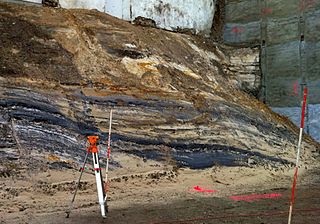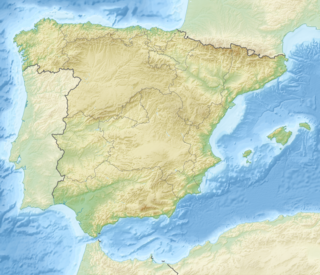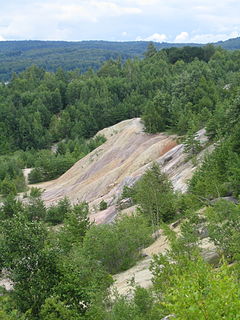 W
WThe Aachen Formation is a Late Cretaceous geologic formation in the southern Netherlands and northeastern Belgium and adjacent Germany.
 W
WThe Arén Formation or Arén Sandstone is a geological formation in the Tremp-Graus Basin around Arén, Catalonia, Spain whose strata date back to the Late Cretaceous. Dinosaur remains are among the fossils that have been recovered from the formation. The formation dates to the Campanian to Maastrichtian and underlies the Tremp Group.
 W
WThe Calcare di Altamura is a Coniacian to early Campanian geologic formation in Italy. The formation comprises limestones that are highly fractured, in places karstified and dolomitized. Fossil ankylosaur tracks have been reported from the formation.
 W
WThe Calizas de Lychnus Formation is a Maastrichtian geologic formation in northern central Spain. Dinosaur remains diagnostic to the genus level are among the fossils that have been recovered from the formation.
 W
WThe Cambridge Greensand is a geological formation in England whose strata are earliest Cenomanian in age. It lies above the erosive contact between the Gault Formation and the Chalk Group in the vicinity of Cambridgeshire, and technically forms the lowest member bed of the West Melbury Marly Chalk Formation. It is a remanié deposit, containing reworked fossils of late Albian age, including those of dinosaurs and pterosaurs.
 W
WThe Chalk Group is the lithostratigraphic unit which contains the Upper Cretaceous limestone succession in southern and eastern England. The same or similar rock sequences occur across the wider northwest European chalk 'province'. It is characterised by thick deposits of chalk, a soft porous white limestone, deposited in a marine environment.
 W
WThe Csehbánya Formation is a geological formation in the Transdanubian Mountains of Veszprém County, Hungary. The formation dates to the Late Santonian of the Late Cretaceous. It represents a floodplain environment as opposed to the swampy lacustrine environment of the simultaneous Ajka Coal Formation, though there is complete overlap in terms of fauna. It underlies the Jákó Marl formation, and laterally transitions to the Ajka Coal Formation.
 W
WThe Gosau Group is a geological stratigraphic group in Austria, Germany and western Slovakia whose strata date back to the Late Cretaceous to Eocene. It is exposed in numerous sporadic isolated basins within the Northern Calcareous Alps. It is divided into two subgroups, the Lower Gosau Subgroup which dates from the Turonian to Campanian, approximately 90 to 75 Ma and the Upper Gosau Subgroup which dates to the Santonian to Eocene, about 83.5 to 50 Ma. The formations within each subunit vary significantly between basins. The sequence is largely marine, but the Grünbach Formation represents a terrestrial deposit. Many of the units of the group are fossiliferous, typically providing marine fossils such as ammonites, though terrestrial remains including those of dinosaurs are known from the Grünbach Formation and Schönleiten Formation.
 W
WArgiles et Grès à Reptiles Formation, also known as the Argiles Rutilantes Formation is an early Maastrichtian French geologic formation in the département of Var preserving the remains of several types of dinosaurs and other extinct organisms.
 W
WThe Grès d'Alet is a Campanian geologic formation in southern France. Fossil dinosaur eggs have been reported from the formation.
 W
WThe Grünbach Formation is an Austrian geological formation that dates to the lower Campanian age of the Late Cretaceous. it forms part of the Gosau Group, and represents a marine regression event, representing a coastal/brackish environment, being underlain by the marine carbonate Maiersdorf Formation and overlain by the deep marine siliciclastic Piesting Formation. The main lithology is Clay, Marl, Siltstone and Sandstone, with a minor Conglomerate component. Coal seams have also been noted. It is notable for its fossils including those of dinosaurs and plants.
 W
WThe Hunstanton Formation is a lithostratigraphic name applied to an early Cretaceous limestone succession in eastern England which was formerly known as Red Chalk. The type section is at Hunstanton Cliff in northwest Norfolk.
 W
WThe Köpinge Sandstone is a highly calcareous and glauconitic sandstone geologic formation of the Vomb Trough in Skåne, southernmost Sweden. The formation dates to the latest early to middle late Campanian stage of the Late Cretaceous and has provided fossils of ammonites, belemnites, the shark Cretalamna borealis and the mosasaurid Tylosaurus, originally described as Hainosaurus. Ex situ occurrences in Pleistocene deposits have provided a dorsal vertebra of a possible elasmosaurid.
 W
WThe Kristianstad Basin is a Cretaceous-age structural basin and geological formation in northeastern Skåne, the southernmost province of Sweden. The basin extends from Hanöbukten, a bay in the Baltic Sea, in the east to the town of Hässleholm in the west and ends with the two horsts Linderödsåsen and Nävlingeåsen in the south. The basin's northern boundary is more diffuse and there are several outlying portions of Cretaceous-age sediments. During the Cretaceous, the region was a shallow subtropical to temperate inland sea and archipelago.
 W
WThe Maastricht Formation, named after the city of Maastricht, the Netherlands, is a geological formation in the Netherlands and Belgium whose strata date back to the Late Cretaceous, within 500,000 years of the Cretaceous–Paleogene boundary, now dated at 66 million years ago. The formation is part of the Chalk Group and is between 30 and 90 metres thick. It crops out in southern parts of Dutch and Belgian Limburg and adjacent areas in Germany. It can be found in the subsurface of northern Belgium and southeastern Netherlands, especially in the Campine Basin and Roer Valley Graben. Dinosaur remains are among the fossils that have been recovered from the formation.
 W
WThe Marnes Rouges Inferieures Formation is a Late Cretaceous geologic formation found in the French Pyrenees. It predominantly consists of red mustone, with minor brown mudstone and sandstone. Dinosaurs, dinosaur eggs and avialian stem-birds have been reported from the formation.
 W
WPeruc-Korycany Formation is a geologic unit of Upper Cretaceous age, located mostly in the Czech Republic. It is the oldest unit of the Bohemian Cretaceous Basin, which overlies metamorphosed rocks of the Bohemian Massif. It consists of fluvial to shallow marine sediments. Dinosaur fossil remains about 94 million years old were found in 2003 near the village Mezholezy (Miskovice), by Kutná Hora. This small ornithopod dinosaur was officially named as Burianosaurus augustai in 2017.
 W
WThe Priesener Formation is a Coniacian geologic formation in the Czech Republic. Dinosaur remains diagnostic to the genus level are among the fossils that have been recovered from the formation.
 W
WThe Pudovkino Formation is a Late Cretaceous (Campanian) geologic formation in Saratov Oblast of European Russia. Pterosaur fossils have been recovered from the marine marls of the formation.
 W
WThe Rybushka Formation is a Campanian geologic formation in the Penza and Saratov Oblasts of European Russia. Pterosaur, fish and invertebrate fossils have been recovered from the formation.
 W
WThe Sânpetru Formation is a early Maastrichtian geologic formation. Dinosaur remains are among the fossils that have been recovered from the formation. It is located in Romania, near Sânpetru village, part of Sântămăria-Orlea commune. It forms a component of the Hațeg Island fauna.
 W
WThe Sierra Perenchiza Formation is a late Campanian to late Maastrichtian geologic formation in Spain. Dinosaur remains are among the fossils that have been recovered from the formation, although none have yet been referred to a specific genus.
 W
WThe Tremp Formation, alternatively described as Tremp Group, is a geological formation in the comarca Pallars Jussà, Lleida, Spain. The formation is restricted to the Tremp or Tremp-Graus Basin, a piggyback foreland basin in the Catalonian Pre-Pyrenees. The formation dates to the Maastrichtian to Thanetian, thus the formation includes the Cretaceous-Paleogene boundary that has been well studied in the area, using paleomagnetism and carbon and oxygen isotopes. The formation comprises several lithologies, from sandstone, conglomerates and shales to marls, siltstones, limestones and lignite and gypsum beds and ranges between 250 and 800 metres in thickness. The Tremp Formation was deposited in a continental to marginally marine fluvial-lacustrine environment characterized by estuarine to deltaic settings.
 W
WThe Ulster White Limestone Group is a late Cretaceous lithostratigraphic group in Northern Ireland. The name is derived from the characteristic chalk rock which occurs particularly along the Antrim coast. The strata are exposed on or near to both the northern and eastern coasts of Antrim and also between Portrush and Dungiven within County Londonderry. Further outcrops occur between Belfast and Lurgan and between Dungannon and Magherafelt. The current names replace an earlier situation where the present group was considered to be a formation and each of the present formations was considered a 'member'. Several other stratigraphic naming schemes were in use during the nineteenth century and much of the twentieth century. This group and the underlying Hibernian Greensands Group are the stratigraphical equivalent of the Chalk Group of southern and eastern England.
 W
WThe Upper Greensand Formation is a Cretaceous formation of Albian to Cenomanian in age. It is found within the Wessex Basin and parts of the Weald Basin in southern England. It overlies the Gault Clay and underlies the Chalk Group. It varies in thickness from zero to 75 m. It is predominantly a glauconitic fine-grained sandstone, locally becoming silty. Fragmenary dinosaurs remains such as those assigned to Iuticosaurus, have been recovered from this formation.
 W
WThe Villalba de la Sierra Formation is a Campanian to Maastrichtian geologic formation in Spain. Fossil dinosaur eggs have been reported from the formation, that comprises gypsiferous, grey, argillaceous mudstones and sandstones, deposited in a floodplain environment. Abundant titanosaurian remains, including Lohuecotitan were found in the formation. More than 10,000 fossil remains of various fishes, amphibians, lizards, dinosaurs, turtles, and crocodiles are also known from the site, one of the richest for the Late Cretaceous in Europe.